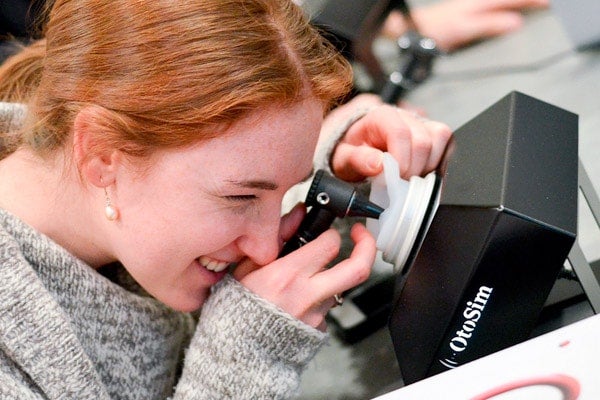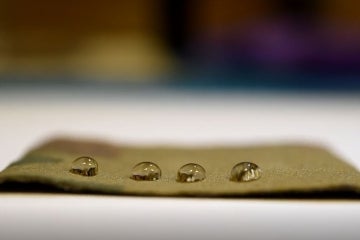
Helping doctors perform better ear examinations
Published: February 28, 2013
From the perspective of a patient, an otoscopy is an almost iconic moment during a visit to a family doctor. The physician takes a small instrument vaguely resembling a hammer and peers through it into first one ear, then another.
But what about the doctor's perpective?
Experts say acquiring the skills to perform an otoscopy properly is difficult - and it's time to change the way medical students are trained. Recently, University of Toronto medical students had the chance to participate in an intensive, one-hour otoscopy workshop using the OtoSim™ — a training and simulation system that is radically changing the way students in Canada and around the world learn this poorly-acquired medical skill.
“It was really helpful,” said Vishaal Gupta, a second-year medical student. “I’ve looked in ears before and you never know what you’re actually looking at; it’s good that they can circle what they’re talking about. The clarity is a big thing because I could actually pinpoint all the little tiny differences. I think it should be used earlier on in training.”
 Dr. Vito Forte and Dr. Paolo Campisi invented the OtoSim™ after perceiving a systemic need among the students and medical professionals they taught for better otoscopic training tools. Forte is a professor in U of T’s Department of Otolaryngology; Campisi is an associate professor and director of Postgraduate Education.
Dr. Vito Forte and Dr. Paolo Campisi invented the OtoSim™ after perceiving a systemic need among the students and medical professionals they taught for better otoscopic training tools. Forte is a professor in U of T’s Department of Otolaryngology; Campisi is an associate professor and director of Postgraduate Education.
Working with a multi-disciplinary team of clinicians, educators, and engineers, they created the OtoSim™ device and its accompanying software to help medical professionals more accurately diagnose ear pathologies.
OtoSim™ training units can be networked in sets of six, allowing instructors to share images with a group of students. For the U of T event, 48 OtoSim™ units were networked via eight instruction hubs, allowing Assistant Professor and Director of Undergraduate Education Dr. Albino Chiodo, along with Lecturer and Co-director Dr. John Lee, both in the Faculty of Medicine’s Department of Otolaryngology, to teach in two one-hour sessions.
“Historically, otoscopy simulation involved looking at an image of an eardrum on a piece of film at the end of a rubber ear,” said Dr. Andrew Sinclair, CEO of OtoSim Inc. “OtoSim™ has a digital image bank that is orders of magnitude more extensive. The instructor can electronically point to areas within the image and confirm that the student sees the pathology of interest. Diagnostic accuracy goes up enormously.”
Organized in part by medical students Lucas Djelic and Joel Davies through Facebook, this event was the largest mass medical simulation exercise ever held for U of T students.
It was part of Triple MD: Mechanisms, Manifestations and Management of Disease, a 36-week course that runs throughout the second year of medical school.
“I love that they’ve got both common, uncommon, and even some quite rare pathology in the OtoSim™ image bank,” said Dr. Ian Witterick, professor and chair of the Department of Otolaryngology. “I’m sure that in future years some of the students going through this program will say, ‘aha,’ I recognize that because I saw it using the OtoSim™.”
 OtoSim Inc.’s technology was brought to market with seed-funding support and services from MaRS Innovation to facilitate the OtoSim’s™ business and product development. Headquartered in the MaRS Discovery District, the company has also received seed-funding and R&D support from the Hospital for Sick Children, The Health Technology Exchange (HTX), Ontario Centres of Excellence, National Research Council Canada’s Industrial Research Assistance Program, MaRS Discovery District’s Business Acceleration Program, and the SickKids Women’s Auxiliary.
OtoSim Inc.’s technology was brought to market with seed-funding support and services from MaRS Innovation to facilitate the OtoSim’s™ business and product development. Headquartered in the MaRS Discovery District, the company has also received seed-funding and R&D support from the Hospital for Sick Children, The Health Technology Exchange (HTX), Ontario Centres of Excellence, National Research Council Canada’s Industrial Research Assistance Program, MaRS Discovery District’s Business Acceleration Program, and the SickKids Women’s Auxiliary.
Its clients include hospitals, universities and medical schools around the world.



